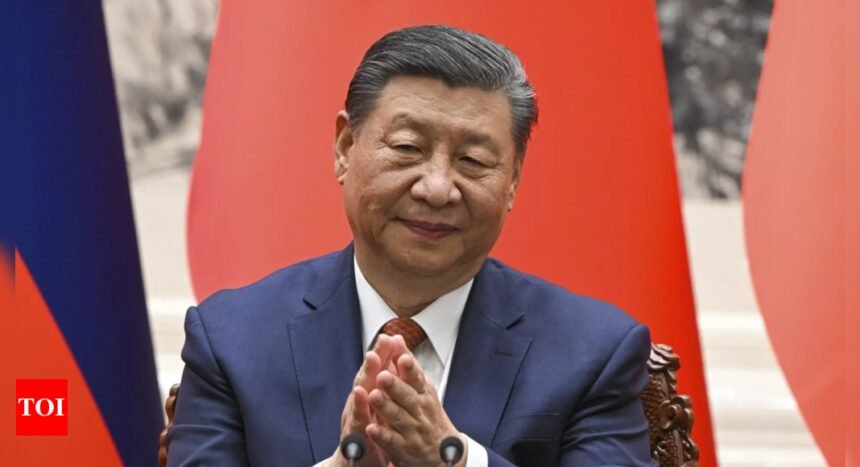It started with a cryptic quote from President Xi Jinping buried in a 172-page book on the financial sector. Three months later, plans for potentially the biggest shift in years in how China conducts monetary policy are starting to surface.
Pan Gongsheng, governor of the People’s Bank of China, on Wednesday gave the clearest acknowledgment that the monetary authority is looking into trading government bonds in the secondary market as a way to regulate liquidity.The PBOC is studying the implementation with the finance ministry and it will be a gradual process, he said in a speech.
That responds to Xi’s directive to “enrich the monetary policy toolbox” and “gradually increase government bond buying and selling in central bank open market operation” in a speech during a financial policy meeting last year, made public only in the book published in March.
On top of that, Pan hinted at other changes to the interest-rate system. The bank may consider moving to using a single short-term rate to guide markets. It’s also considering narrowing the corridor within which market rates are allowed to fluctuate to signal a clearer policy target.
To be sure, all these moves aim to refine the technical tools that the PBOC uses to manage interest rates and money. They won’t necessarily help answer some of the big questions that confront Chinese policymakers right now — like whether credit can prop up the economy when households and companies aren’t eager to take on more debt, or how to ease borrowing costs without weakening the yuan. Many details remain vague, along with the timeline for change.
PBOC watchers see the proposals as part of a long-running effort in which the central bank ultimately seeks to guide market interest rates rather than setting them directly — and a step further away from the command economy where officials determined both the price and the quantity of credit. Pan said on Wednesday that it’s time to pay less attention to targets like the pace of loan growth because borrowing by real estate developers and local governments is in decline as part of the economy’s transition.
“Moving to one short-term interest rate that is connected to the financial market as the main policy rate would be an obvious further step in the gradual reform of China’s monetary policy framework,” said Louis Kuijs, chief Asia-Pacific economist for S&P Global Ratings. “It would make the framework simpler and more transparent, and bring it closer to the ‘industry standard’ as practiced in most advanced economies.”
One conclusion many analysts drew from Pan’s speech is that the PBOC is preparing to downplay what’s been one of its headline instruments: the one-year policy loans known as the medium-term lending facility. Since it was introduced a decade ago, the MLF has become a major channel for the central bank to inject money into the economy and guide market rates.
But in recent months, banks’ demand for these funds has languished as it became cheaper for them to borrow from each other. The interest rate on the MLF has been held steady for 10 months, even as other borrowing costs in the economy plunged — partly because the PBOC is wary of currency depreciation.
What’s more, the MLF is also only available to selected banks. By buying and selling sovereign bonds as an alternative way of managing liquidity, central bankers can influence financial conditions across a wider range of market participants. And compared with the MLF, the rate on seven-day reverse repurchases — short-term loans available to banks every day — offers more flexibility for policy fine-tuning.
Pan may believe that China’s rates market is now mature enough for the central bank to stop using multiple anchors to guide it, according to Serena Zhou, senior China economist at Mizuho Securities Asia Ltd.
Financial News, a newspaper managed by the PBOC, on Thursday cited unnamed industry experts as saying that the central bank should weaken the link between MLF — which represents banks’ financing costs — and the loan prime rate, a benchmark for lending rates to the real economy. The latter is more important because actual borrowers’ costs matters more for economic growth, according to the report.
Currently, the LPRs are based on the interest rates that 20 banks offer their best customers. They are quoted as a spread over the MLF rate.
One likely goal is to ensure a smoother transmission mechanism from short-term interest rates to longer ones.
The PBOC’s current setup of using two policy rates — the seven-day reverse repo and the MLF — reduces the signaling effect from its monetary decisions, Macquarie Group Ltd. economists led by Larry Hu argued in a report on Thursday.
In addition, the current interest rate corridor constructed by the PBOC — the range within which market rates are supposed to move — is too wide, they said, leading to a highly volatile market for seven-day interbank lending by comparison with much more stable rates in the US and Europe.
Pan Gongsheng, governor of the People’s Bank of China, on Wednesday gave the clearest acknowledgment that the monetary authority is looking into trading government bonds in the secondary market as a way to regulate liquidity.The PBOC is studying the implementation with the finance ministry and it will be a gradual process, he said in a speech.
That responds to Xi’s directive to “enrich the monetary policy toolbox” and “gradually increase government bond buying and selling in central bank open market operation” in a speech during a financial policy meeting last year, made public only in the book published in March.
On top of that, Pan hinted at other changes to the interest-rate system. The bank may consider moving to using a single short-term rate to guide markets. It’s also considering narrowing the corridor within which market rates are allowed to fluctuate to signal a clearer policy target.
To be sure, all these moves aim to refine the technical tools that the PBOC uses to manage interest rates and money. They won’t necessarily help answer some of the big questions that confront Chinese policymakers right now — like whether credit can prop up the economy when households and companies aren’t eager to take on more debt, or how to ease borrowing costs without weakening the yuan. Many details remain vague, along with the timeline for change.
PBOC watchers see the proposals as part of a long-running effort in which the central bank ultimately seeks to guide market interest rates rather than setting them directly — and a step further away from the command economy where officials determined both the price and the quantity of credit. Pan said on Wednesday that it’s time to pay less attention to targets like the pace of loan growth because borrowing by real estate developers and local governments is in decline as part of the economy’s transition.
“Moving to one short-term interest rate that is connected to the financial market as the main policy rate would be an obvious further step in the gradual reform of China’s monetary policy framework,” said Louis Kuijs, chief Asia-Pacific economist for S&P Global Ratings. “It would make the framework simpler and more transparent, and bring it closer to the ‘industry standard’ as practiced in most advanced economies.”
One conclusion many analysts drew from Pan’s speech is that the PBOC is preparing to downplay what’s been one of its headline instruments: the one-year policy loans known as the medium-term lending facility. Since it was introduced a decade ago, the MLF has become a major channel for the central bank to inject money into the economy and guide market rates.
But in recent months, banks’ demand for these funds has languished as it became cheaper for them to borrow from each other. The interest rate on the MLF has been held steady for 10 months, even as other borrowing costs in the economy plunged — partly because the PBOC is wary of currency depreciation.
What’s more, the MLF is also only available to selected banks. By buying and selling sovereign bonds as an alternative way of managing liquidity, central bankers can influence financial conditions across a wider range of market participants. And compared with the MLF, the rate on seven-day reverse repurchases — short-term loans available to banks every day — offers more flexibility for policy fine-tuning.
Pan may believe that China’s rates market is now mature enough for the central bank to stop using multiple anchors to guide it, according to Serena Zhou, senior China economist at Mizuho Securities Asia Ltd.
Financial News, a newspaper managed by the PBOC, on Thursday cited unnamed industry experts as saying that the central bank should weaken the link between MLF — which represents banks’ financing costs — and the loan prime rate, a benchmark for lending rates to the real economy. The latter is more important because actual borrowers’ costs matters more for economic growth, according to the report.
Currently, the LPRs are based on the interest rates that 20 banks offer their best customers. They are quoted as a spread over the MLF rate.
One likely goal is to ensure a smoother transmission mechanism from short-term interest rates to longer ones.
The PBOC’s current setup of using two policy rates — the seven-day reverse repo and the MLF — reduces the signaling effect from its monetary decisions, Macquarie Group Ltd. economists led by Larry Hu argued in a report on Thursday.
In addition, the current interest rate corridor constructed by the PBOC — the range within which market rates are supposed to move — is too wide, they said, leading to a highly volatile market for seven-day interbank lending by comparison with much more stable rates in the US and Europe.









